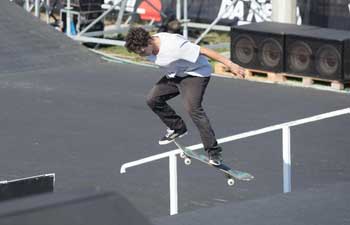WASHINGTON, May 31 (Xinhua) -- A University of Maryland-led study described the first observations of the process of electron heating in Earth's bow shock, a bow-shaped wave ahead of Earth as the planet pushes through the solar wind, a process that helps slow the tempestuous solar wind to a gentle breeze.
A study published on Thursday in the journal Physical Review Letters revealed that when the electrons in the solar wind encountered the bow shock, they momentarily accelerated to a high speed that the electron stream became unstable and breaks down.
This breakdown process robbed the electrons of their high speed and converted the energy to heat, according to the study.
As Earth orbits the sun at supersonic speed, it cuts a path through the solar wind. This fast stream of charged particles, or plasma, launched from the sun's outer layers would bombard Earth's atmosphere if not for the protection of Earth's magnetic field.
Scientists have sought to explain how Earth's magnetic field can shove aside the powerful solar wind without unleashing calamity. They have known part of the answer for a long time: the bow shock converts energy from the solar wind to heat stored in electrons and ions. But now, researchers have important new clues about how this process occurs.
"If you were to stand on a mountaintop, you might get knocked over by a fast wind," explained Chen Li-Jen, lead author of the study and an associate research scientist in the university's Department of Astronomy.
"Fortunately, as the solar wind crashes into Earth's magnetic field, the bow shock protects us by slowing down this wind and changing it to a nice, warm breeze. We now have a better idea how this happens."
The scientists obtained their data from NASA's Magnetospheric Multiscale (MMS) mission. The MMS mission consists of four identical satellites that carry instruments to study the physics of Earth's magnetic field as it interacts with the solar wind.
The satellites obtained three-dimensional measurements every 30 milliseconds, resulting in hundreds of measurements within the bow shock layer.
"The extremely fast measurements from MMS allowed us finally to see the electron heating process in the thin shock layer," said Thomas Moore, a senior project scientist at NASA's Goddard Space Flight Center and a co-author of the study.
The researchers observed the solar wind's electron stream before, during and after meeting with the bow shock. The electron stream accelerated by the shock only took 90 milliseconds to destabilize and fully break down.

















